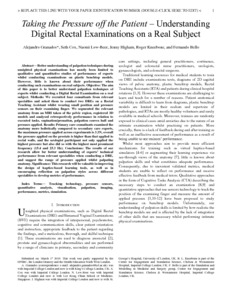Granados, A; Cox, S; Low-Beer, N; Higham, J; Kneebone, R; Bello, F
(2020)
Taking the Pressure Off the Patient - Understanding Digital Rectal Examinations on a Real Subject.
IEEE Trans Biomed Eng, 67 (10).
pp. 2798-2805.
ISSN 1558-2531
https://doi.org/10.1109/TBME.2020.2971826
SGUL Authors: Higham, Jennifer Mary
![[img]](https://openaccess.sgul.ac.uk/112491/1.hassmallThumbnailVersion/FINAL-VERSION.pdf)  Preview |
|
PDF
Accepted Version
Available under License ["licenses_description_publisher" not defined].
Download (1MB)
| Preview
|
Abstract
Better understanding of palpation techniques during unsighted physical examinations has mostly been limited to qualitative and quantitative studies of performance of experts whilst conducting examinations on plastic benchtop models. However, little is known about their performance when conducting such examinations on real subjects. OBJECTIVE: The aim of this paper is to better understand palpation techniques of experts whilst conducting a Digital Rectal Examination on a real subject. METHODS: We recruited four consultants from relevant specialties and asked them to conduct two DREs on a Rectal Teaching Assistant whilst wearing small position and pressure sensors on their examining finger. We segmented the relevant anatomy from an MRI taken of the pelvic region, registered 3D models and analysed retrospectively performance in relation to executed tasks, supination/pronation, palpation convex hull and pressure applied. RESULTS: Primary care consultants examined the anatomy more holistically compared to secondary care experts, the maximum pressure applied across experiments is 3.3N, overall the pressure applied on the prostate is higher than that applied to rectal walls, and the urologist participant not only applied the highest pressure but also did so with the highest most prominent frequency (15.4 and 25.3 Hz). CONCLUSIONS: The results of our research allow for better understanding of experts' technical performance from relevant specialities when conducting a DRE, and suggest the range of pressure applied whilst palpating anatomy. SIGNIFICANCE: This research will be valuable in improving the design of haptics-based learning tools, as well as in encouraging reflection on palpation styles across different specialities to develop metrics of performance.
| Item Type: |
Article
|
| Additional Information: |
© © 2020 IEEE. Personal use of this material is permitted. Permission from IEEE must be obtained for all other uses, in any current or future media, including reprinting/republishing this material for advertising or promotional purposes, creating new collective works, for resale or redistribution to servers or lists, or reuse of any copyrighted component of this work in other works. |
| Keywords: |
Fingers, Pressure sensors, Task analysis, Hospitals, Pelvis, Irrigation, Tracking technology, pressure sensors, quantitative analysis, visualisation, palpation, imaging, performance, metrics, simulation, 0903 Biomedical Engineering, 0906 Electrical and Electronic Engineering, 0801 Artificial Intelligence and Image Processing, Biomedical Engineering |
| Journal or Publication Title: |
IEEE Trans Biomed Eng |
| ISSN: |
1558-2531 |
| Language: |
eng |
| Publisher License: |
Publisher's own licence |
| Projects: |
| Project ID | Funder | Funder ID |
|---|
| UNSPECIFIED | Engineering and Physical Sciences Research Council | http://dx.doi.org/10.13039/501100000266 | | UNSPECIFIED | London Deanery | UNSPECIFIED | | UNSPECIFIED | Health Education North West London | UNSPECIFIED |
|
| PubMed ID: |
32031926 |
| Web of Science ID: |
WOS:000571741600010 |
| Dates: |
| Date |
Event |
| 2020-10 |
Published |
| 2020-02-05 |
Published Online |
| 2020-02-01 |
Accepted |
|
 |
Go to PubMed abstract |
| URI: |
https://openaccess.sgul.ac.uk/id/eprint/112491 |
| Publisher's version: |
https://doi.org/10.1109/TBME.2020.2971826 |
Statistics
Item downloaded times since 14 Oct 2020.
Actions (login required)
 |
Edit Item |



